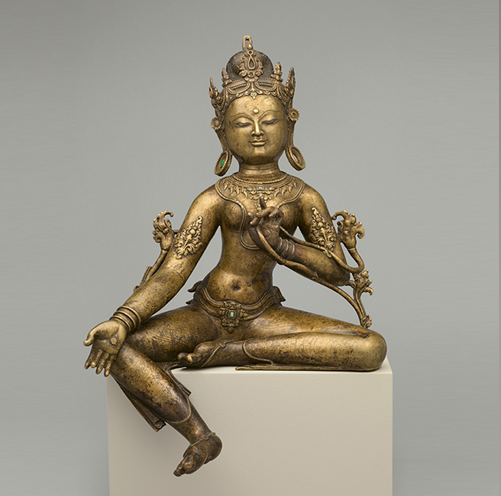
ABOUT THE MEDITATION
This week’s meditation session is led by Tracy Cochran and the theme is: Reawaken.
The guided meditation begins at 12:06.
For centuries Himalayan practitioners have used meditation to quiet the mind, open the heart, calm the nervous system, and increase focus. Now Western scientists, business leaders, and the secular world have embraced meditation as a vital tool for brain health.
Whether you’re a beginner, a dabbler, or a skilled meditator seeking the company of others, join expert teachers in a forty-five-minute weekly program designed to fit into your lunch break. Each session will be inspired by a different work of art from the Rubin Museum’s collection and will include an opening talk, a twenty-minute meditation session, and a closing discussion.
RELATED ARTWORK

Tara is a completely enlightened Buddha, who has promised to appear in the future in the form of a female bodhisattva and deity for the benefit of all beings. Tara typically appears in the form of a radiant young woman. The green form of Tara is known for bestowing protection from the Eight Fears. She helps us to overcome internal and external states of turmoil. Tara is beloved in all Schools of Tibetan Buddhism.
This 13th century work of art is a remarkable example of early Tibetan sculpture. Its distinguishing features include the proportionally large head, the distinctive hoop earrings, and the subtle sense of motion of the figure. Early Tibetan sculptures such as this one have a strong Indian art influence.
Green Tara embodies compassionate action and the willingness to embrace all beings without judgment. Her 10-syllable mantra Om Tare Tuttare Ture Svaha is memorized and recited by Tibetans from early childhood. Reciting this mantra with devotion strengthens our connection to Tara, bestows us with protection, and helps us accrue merit.
ABOUT THE SPEAKER

Tracy Cochran has been a student and teacher of meditation and spiritual practice for decades. She is the founder of the Hudson River Sangha, which is now virtual and is open to all. The link for her weekly meditations can be found on her website:tracycochran.org.
In addition to the Rubin Museum of Art, Tracy has taught mindfulness meditation and mindful writing at the New York Insight Meditation Center, as well as in schools, corporations, and other venues nationally and internationally. She is also a writer and the editorial director of Parabola, an acclaimed quarterly magazine that seeks to bring timeless spiritual wisdom to the burning questions of the day. Her writings, podcasts, and other details can be found on her website and at parabola.org.
This program is presented in partnership with Sharon Salzberg and teachers from the New York Insight Meditation Center, the Interdependence Project, and Parabola Magazine and supported by the Frederick P. Lenz Foundation for American Buddhism.

